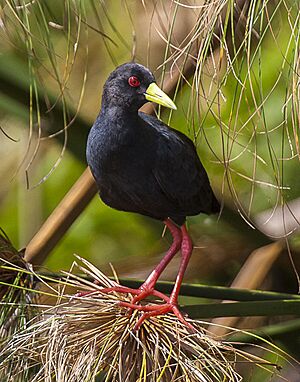Black crake facts for kids
Quick facts for kids Black crake |
|
|---|---|
 |
|
| Conservation status | |
| Scientific classification | |
| Genus: |
Zapornia
|
| Species: |
flavirostra
|
| Synonyms | |
|
Zapornia flavirostris |
|
The black crake (Zapornia flavirostra) is a small waterbird that belongs to the rail and crake family. These birds live in most parts of sub-Saharan Africa, avoiding only very dry areas. Black crakes sometimes move to different places during the year, especially when their home areas experience dry seasons.
Contents
Meet the Black Crake: Appearance and Sounds
The black crake is a small bird, about 19–23 cm (7.5–9.1 in) long. It has a short tail and long toes. As its name suggests, this bird is mostly black. Its wings and upper body have a slight brownish-olive color, but this is hard to see when you spot them in nature.
What Does a Black Crake Look Like?
A grown-up black crake has bright red eyes. Its beak is yellow, which is why its scientific name, flavirostra, means "yellow-billed." Its legs and feet are red, though they look a bit duller when the bird is not breeding.
Male and female black crakes look very similar. However, males are usually a little bigger. Also, most males have a hooked upper part of their beak, but only a few females do. Young black crakes have brown upper parts and dark gray heads and undersides. Their beaks are greenish-yellow, and their legs and feet are dull red. Baby crakes are born with black, fluffy down, just like all rail chicks.
What Sounds Do Black Crakes Make?
Black crakes often sing together in a duet. One bird starts with a deep, chattering sound, like krrrok-kraaaa. The other bird then replies with a soft, dove-like cooing sound, coo-crr-COO.
Black Crake Life: Where They Live and What They Do
Black crakes are quite common birds. They live in all kinds of freshwater marshes, as long as there are enough plants for them to hide in. Unlike many other rails, black crakes are often seen out in the open. They have even benefited from humans clearing forests, which creates more marshy areas for them.
Building a Home: Black Crake Nests
When it's time to breed, black crakes become very protective of their territory. They will even attack and fight other birds, especially other rails, even if those birds are as big as they are!
Both the male and female black crake work together to build their nest. It's a deep, neat bowl made from plants found in wetlands. They usually build it among marsh plants or on dry ground. Sometimes, they might even build a nest up to 3 m (9.8 ft) high in a bush!
Eggs and Chicks
Female black crakes usually lay two to six eggs, but often it's three. The eggs are cream or white with brown or chestnut spots. Both parents take turns sitting on the eggs to keep them warm. This incubation period lasts about 13 to 19 days. Sometimes, young birds from previous broods (older siblings) help their parents.
When the chicks hatch, they are ready to leave the nest in just 1 to 3 days. However, their parents and any helpers will feed them for several weeks. The young crakes can fly when they are about 5 to 6 weeks old and become fully independent between 6 and 12 weeks.
What Do Black Crakes Eat?
Black crakes are active during the day. They are quite comfortable around people and often feed out in the open. They eat a wide variety of foods, including many different invertebrates (like insects), small fish, frogs, and seeds. They will also eat the eggs of other birds and sometimes scavenge on dead animals.
These clever birds look for food on the ground or climb up reeds to catch prey, including flying insects. Interestingly, black crakes have been seen perching on large animals like hippopotamuses and warthogs to pick off parasites from their skin!


